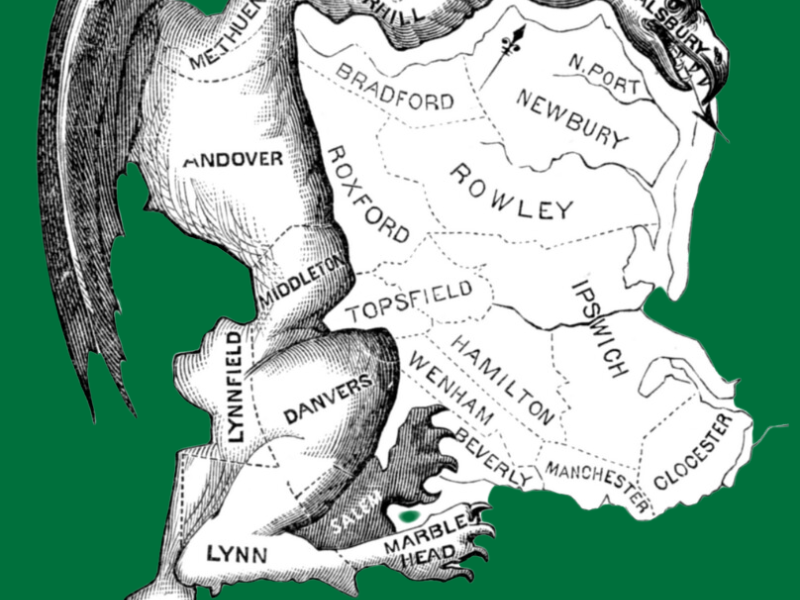Comparing the U.S. to almost any other democracy, we have the craziest districts. Districts in the U.K., for example, do not at all look like districts here. U.K. districts vary significantly in population, and ours hardly at all. And, their districts are compact and generally respect local jurisdictions, while many of our districts are serpentine, slithering about from one to another part of a state, and crossing local jurisdictional lines willy-nilly.
We call our contorted districts gerrymanders, after Massachusetts Governor Elbridge Gerry and the state senate district that he proposed in 1812 that slithered about the towns of the state like a salamander.

In large part, the difference between U.K. and U.S. districts reflects attempts by the U.S. to assure one man one vote in the face of historic racism.
Going way back, almost all districts were coincident with county borders, often with the result of over-representation of rural voters. With Baker v. Carr (1962), the U.S. Supreme Court required that legislative districts be close to equal in population and, thus, mandated redistricting with the decennial census and the splitting of jurisdictions.
The Voting Rights Act (VRA) of 1965 was to enable blacks to be more fairly represented both by assuring the right to vote and by requiring so-called VRA districts, sometimes called majority-minority districts. As a consequence of the VRA, serpentine districts became acceptable if their purpose was to bring together enough minority voters to constitute a majority within the district.
These two things opened up a pandora’s box, enabling majority parties to cement their hold onto power, contributing to one-party rule in many parts of the country, and to the polarization of the American political spectrum. While securing the right to vote is a worthy goal, the evils of gerrymandering undermine democracy and make voting meaningless in many places.
We’ll use New York State as a case in point. In 1945, Adam Clayton Powell, Jr., became the first African American elected to Congress from New York. He joined one other African American in Congress, elected from Illinois. Significantly, Powell was elected from a newly-drawn congressional district encompassing Harlem, a neighborhood that – despite the Dutch origin of the name – became majority African American during the Great Internal Migration of the early 20th Century.
In 1968, Shirley Chishom became the first African American woman elected to Congress. Significantly, she represented another majority black district. Her district encompassed Bedford-Stuyvesant of Brooklyn. This neighborhood, despite the English and Dutch origins of its name, also became majority African American. The district was created by a court order. Previously, its population had been split among several districts that reached from “Bed-Stuy” into neighborhoods dominated by voters of European descent.
The concentration of blacks and, to a lesser extent other minorities, into certain neighborhoods would seem to make drawing majority-minority districts feasible. Just don’t split these voters up. Districts in New York are required, by state law, to be contiguous, compact, and respect “the historic and traditional significance of counties.” If this law were followed, a good number of majority-minority districts should naturally be drawn. But, there are partisan considerations.
Politicians want to draw districts that concentrate the voters of the other party into a few districts and maximize the number of districts in which their party has a moderately-strong advantage. If it were possible, politicians would like to configure ten districts of a 50-50 state so that two districts are overwhelming of the other party (85 to 15), and eight districts moderately-strongly favor their party (60 to 40). The restrictions that districts be contiguous and respect minority voters hampers achieving such a map, but not by much. Politicians have become adept at drawing lines; and, state laws requiring that districts be compact and reflect communities of interest have become dead letters.
A recent Supreme Court decision (Allen v. Milligan 2023) points to continued problems in redistricting. The decision mandates that majority-minority districts be drawn when this doesn’t require excessive gerrymandering. Federal law, then, requires that congressional districts be of approximately equal population, contiguous, and provide majority-minority districts when this doesn’t require excessive gerrymandering. Federal law allows, but does not mandate, gerrymandering whether for minority representation or simply for partisan advantage, subject perhaps to state laws requiring consideration of, e.g., communities of interest.
The focus of many current court cases involving redistricting is, thus, whether additional minority-majority districts can be drawn without too much gerrymandering. Among these cases are a Georgia case and a Michigan case. The first is potentially to the advantage of the Democratic Party, and the second to the potential advantage of the Republican Party. The Georgia case involves too much packing of minority voters into a few districts, to the advantage of the Republicans. And, the Michigan case involves so much spreading of minority voters to additional districts, to the advantage of the Democrats (but to the disadvantage of minority voters).
Congress might well consider tightening its rules for redistricting. For example, counties that qualify for one or more whole Congressional districts, should usually have that many districts, with any residual gathered into one or two segments to be added to districts of adjoining counties. Within counties, there could be analogous handling of subordinate jurisdictions such as cities and towns. Subject to the just stated rule, majority-minority districts would be required where these are possible. If the above mandate doesn’t sufficiently assure voting rights, an allowed deviation from the rule can be made to allow majority-minority districts that cross jurisdiction lines but are nevertheless compact. While allowing any deviation from respecting jurisdiction lines invites mischief, preserving voting rights is a high priority.
Photo credit: Public domain.





